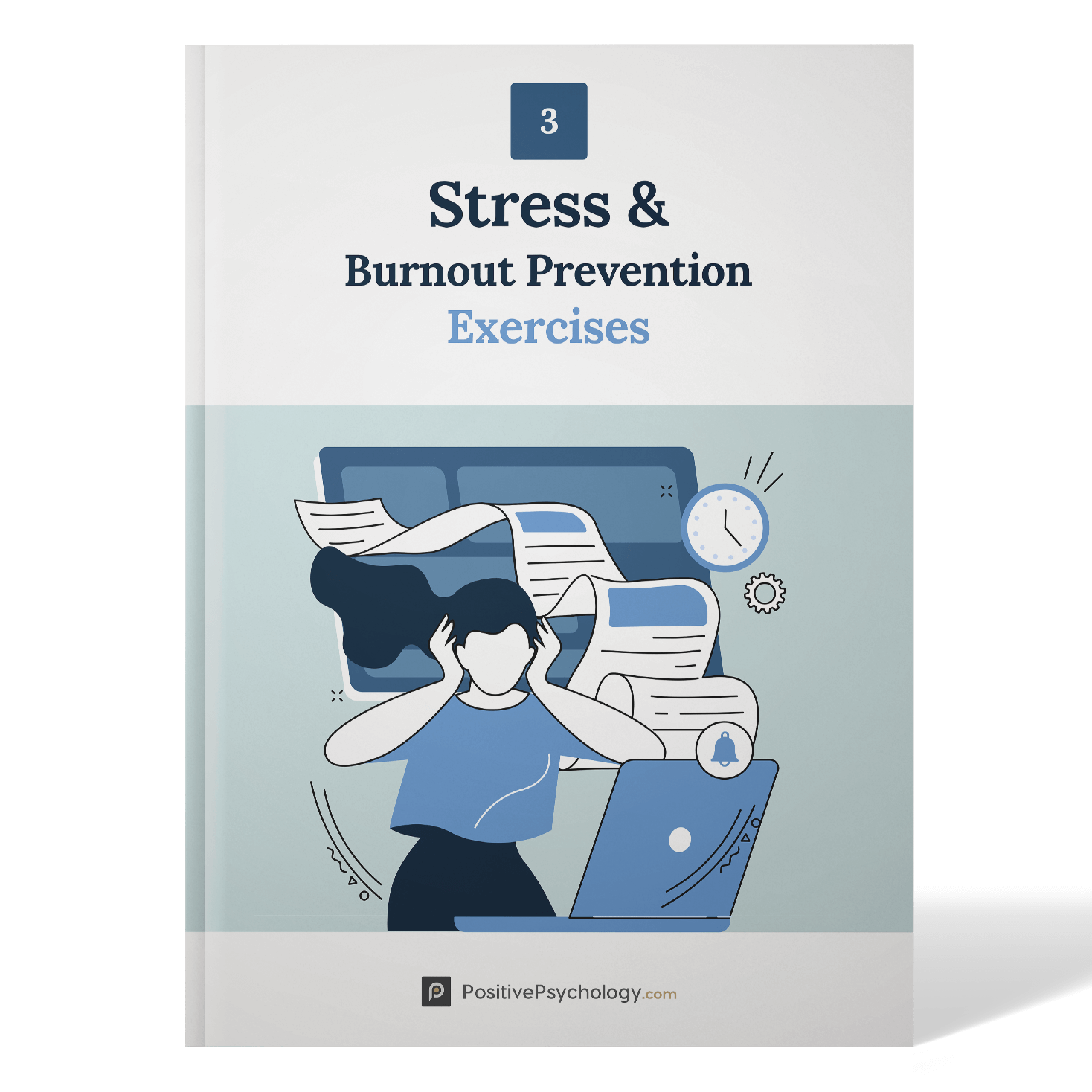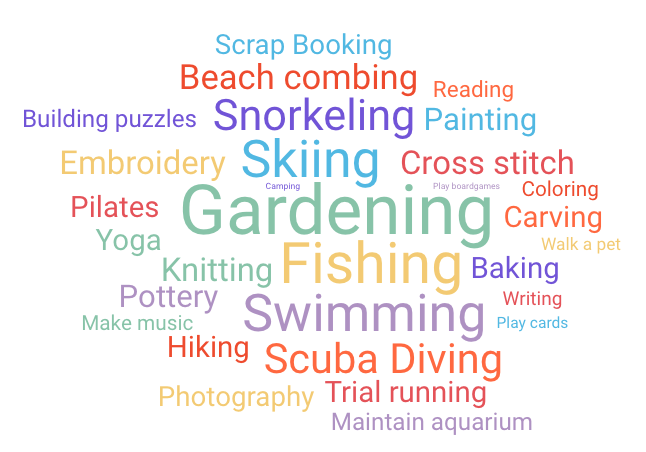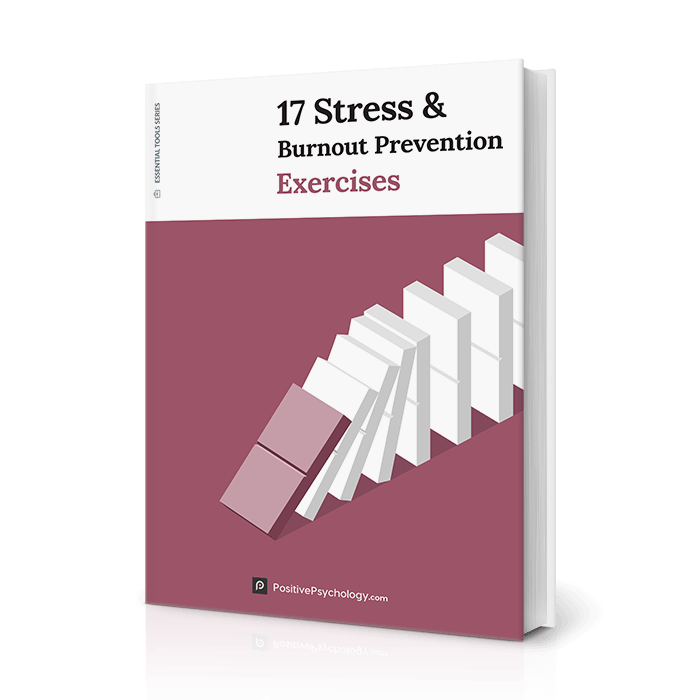How to Relieve Stress: 37 Simple Activities and Games
 Periodic stress is a fact of modern life.
Periodic stress is a fact of modern life.
But we need not see stress as something perpetual, punishing, and unmanageable.
Instead, by learning to apply some simple techniques and cultivating an interest in activities that facilitate stress relief, stress management can become as mundane and manageable as commuting to work or cleaning your house.
Want to know how you can help your clients relieve stress? Read on for an interesting overview of what stress actually is, the good and the bad, as well as simple ways to implement stress relief into a daily routine.
Before you continue, we thought you might like to download our three Stress & Burnout Prevention Exercises (PDF) for free. These science-based exercises will equip you and your clients with tools to manage stress better and find a healthier balance in your life.
This Article Contains:
What Is Stress? A Psychological Definition
Despite being something most people encounter almost every day, stress is a deceptively complex phenomenon. It is a psychophysical process, meaning that it comprises both mental and physical features and can be experienced and defined in two separate ways.
Mental stress
Stress as a mental phenomenon is characterized by feelings of negative emotions triggered by the presence of a perceived stressor, which may be an event, another individual, an object, or something more abstract such as a particular thought or a personal trait.
The important detail to note here is that the stressor is perceived, meaning that an individual’s prior set of beliefs and expectations about the world are highly influential in their experience of stress. What one individual perceives to be a stressor, another individual may interpret as unremarkable (Porter & Goolkasian, 2019).
Physical stress
Stress as a physical phenomenon is characterized by a cascade of activity throughout the body. This cascade begins in the brain, as regions responsible for releasing stress hormones, preparing stress-related motor movements, and encoding stress-related emotional and cognitive responses become activated.
The downstream consequences of this activation then spread throughout the body. Heart rate increases, energy reserves are metabolized, digestion is paused, and the body enters a state of threat readiness (Marshall, 2011; Godoy, Rossignoli, Delfino-Pereira, Garcia-Cairasco, & Umeoka, 2018).
As a therapist, you will likely be primarily concerned with stress as a mental phenomenon, with your primary outcome being to reduce stress-related negative emotion or patterns of cognition that enable stress. However, it is important to appreciate how these two different types of stress interact.
For example, while mental stress can drive physical stress, sometimes the opposite is true, as a state of otherwise meaningless physical tension causes an individual to generate meaningful negative thoughts. Likewise, sometimes mental stress might occur independently of any clear signs of physical stress, and vice versa.
Threat stress and challenge stress
Not all stress is negative, and encouraging a sweeping policy of stress avoidance may actually do more harm than good. This can be illustrated by considering the difference between ‘threat stress’ and ‘challenge stress’ (Porter & Goolkasian, 2019).
Threat stress is associated with fear, alarm, and negative emotion, and represents a response to situations in which an individual feels overwhelmed and at risk of (emotional, social, or physical) harm. This stress is harmful and should be considered a legitimate therapeutic target.
In contrast, challenge stress is associated with situations in which an individual may feel a certain amount of apprehension, but simultaneously feels an exciting or otherwise compelling drive to face the situation and overcome its difficulties.
While nevertheless uncomfortable, this stress is constructive and can be a force for self-improvement and growth. Encouraging an individual to avoid challenge stress could lead to stagnation and the inability to confront difficult but ultimately therapeutic experiences.
For more on positive stress, we recommend spending a few minutes reading through our article on eustress.
How to Relieve Stress: 5 Techniques

These can be practiced independently by your client, or they can take the shape of a more deliberate, guided exercise as part of their therapy. However, it is first worthwhile considering whether your client uses a problem-focused or an emotion-focused coping strategy to manage their stress (Folkman & Moskowitz, 2004).
Problem-focused coping is characterized by directly tackling the source of the stress to remove it. For example, if someone is stressed by too much pressure at work, the problem-focused strategy might be to speak to a manager or colleague to relieve that pressure.
In contrast, emotion-focused coping is characterized by tackling the negative emotions produced by the source of the stress. For example, many sources of stress are more or less intractable, and so the most natural way to cope with them is to relieve their emotional impact.
Progressive muscle relaxation
Progressive muscle relaxation is a straightforward technique that involves sequentially contracting and then relaxing muscle groups throughout the body, typically starting from one extremity (e.g., the feet) and ending at the opposite (e.g., the face/neck).
Muscles are contracted deliberately and slowly, with clients typically maintaining the contraction for around 10 seconds. As well as providing a pleasant physical sensation that may relieve stress-related tension in the body, this technique also provides a period of quiet focus that helps to ground an individual and prevent their mind from spiraling.
Biofeedback
Biofeedback is an interesting technique that exploits the reciprocal link between the mind and body. Biofeedback can take many forms, but the basic procedure is that an individual observes a real-time readout of some aspect of their physiological activity.
For example, this might be heart rate (e.g., using commercially available fitness monitors), skin temperature, or even electrical brain activity (e.g., using wearable EEG or fNIR equipment). The individual then tries to relax and receives immediate feedback on any physiological changes caused by their efforts.
The individual learns what does and doesn’t work, and can precisely measure the success of their practice. Eventually, the individual learns a relaxation strategy to a sufficient extent that they no longer require biofeedback and can implement it in their daily life.
Guided imagery
Guided imagery is akin to a mind-based form of progressive muscle relaxation. The individual imagines a rich and immersive visual scene or image, typically constructing it and navigating through it in a deliberate sequence.
Importantly, whatever is imagined represents something soothing and pleasant, so the individual is not only distracted from their stress but also actively relieved. While this technique is typically guided, an individual can also act as their own guide by developing one or more stereotyped images or scenes they can construct independently.
Breathing
Breathing-based stress-relief techniques involve focusing on a period of deliberate, timed breathing. Most techniques involve around five deep breaths per minute, but there are many varieties of breathing-based techniques with different intervals between breaths and different intended benefits.
All have the primary aim of relaxation, and all likely work via a similar mechanism, wherein the brain notices the body entering a relaxed state akin to rest or sleeping and reduces its perceived state of stress and alertness accordingly.
Meditation and mindfulness
Finally, meditation and mindfulness refer to a broad range of techniques that combine the above techniques in a single discipline.
For example, meditation practices often involve breathing techniques and an emphasis on mental and physical grounding.
Mindfulness practices are often less formal but involve a similar emphasis on an individual deliberately focusing on and understanding the shifting states of their own mind and body.
In both cases, the overall aim is to alter the process that connects perception to stress, both by building a greater resilience to stress and taking apart the harmful and often automatic thought processes that cause a potentially innocuous situation to be perceived as stressful.
2 Stress-Relief Activities for Adults
Stress-relief activities can be sorted into two categories: breathers and restorers (Pressman et al., 2009).
Breathers
Breathers emphasize emotion-focused coping and involve an individual taking a break to distract themselves from the cause of their stress and substitute negative emotion with positive feelings and stimulation.
Breathers can be anything from high-octane activities like sports to leisurely activities such as jetting off on vacation, or even activities as simple as taking a 15-minute coffee break.
Restorers
In contrast, restorers emphasize problem-focused coping by working to repair stress-related emotional or physical damage that is perpetuating feelings of stress.
This might involve taking a mental health break, receiving comfort and care from friends or loved ones, going to a spa or other therapeutic retreats, or simply having a proper meal and eight hours of sleep after weeks of deprivation.
An individual should consider their needs before deciding on a stress-relief activity. Are they looking for escape, or do they need to heal?
3-Minute stress management: reduce stress with this short activity
Best In-Person and Online Games
Games are great for relieving stress. Below is a quick recap on which types can help with stress relief.
Sports and physical exercise
Sports and physical exercise are well-established methods of stress reduction. They provide catharsis, literally working out bottled-up stress-related physical tension and negative emotion, and provide a focus that can distract an individual from nagging sources of stress (Takeda, Noguchi, Monma, & Tamiya, 2015).
There is nowhere to go wrong and a huge range of possible activities to choose from, anything from artistic swimming to endurance running can be an effective method of stress relief.
Nevertheless, an individual should pick an activity that suits their strengths, interests, and preferences. For example, some individuals may prefer a sport that is more or less social than others, and where the risk of physical harm may be stimulating for some, others might find this counter-productive as a means of stress relief.
Video games
Similarly, despite some controversy over the years, video games are also recognized as a legitimate and widely used method of stress relief. However, anyone who has played video games knows that they can be a mixed bag in terms of stress relief, and there is no way to speak about gaming in broad strokes.
Some games are designed to be highly addictive and can be counter-productive in the context of stress relief; indeed, many video games are stress inducing as a deliberate feature of their design.
The most effective games for stress relief are casual games involving low stakes, low commitment, and no particular pressure or incentive to continue to play when the player wants to stop (Russoniello, O’Brien, & Parks, 2009). Solitaire anyone?
Playing together versus playing alone
Ultimately, the goal of taking part in a stress-relieving activity is participation. If an individual finds that a sport or video game is engaging, relaxing, or otherwise distracts them from their stress, then there might not be any benefit in analyzing it further.
However, it is worth considering that research suggests team-based activities may be more effective at enhancing mental wellbeing than activities performed individually, with lower rates of depression and anxiety reported by team sport athletes than individual sport athletes (Pluhar et al., 2019).
It may also be useful to consider whether the sport activity or video game is focused on cooperation or competition. Interestingly, while you might assume that sports and games involving competition only introduce an additional source of stress, research has shown that both cooperation and competition are equally effective, suggesting that healthy competition may have a literal meaning as well as a figurative one (Roy & Ferguson, 2016).
30+ Hobbies and Ideas for Managing Stress
Stress can often take the shape of a negative, looming presence in our lives that we cultivate and grow as an unfortunate and sometimes unavoidable consequence of the choices we make.
Hobbies provide a means of countering this by cultivating an opposing positive force in our lives.
Stress-relieving hobbies
Stress-relieving hobbies should be goal based with measurable progress in order to provide a satisfying and productive focus to distract an individual and relieve their stress.
For example, crafts like knitting, carving, pottery, and painting are engrossing, challenging, but ultimately satisfying and involve cultivating something that persists beyond the individual’s engagement in the activity.
Hobbies that foster patience and resilience may be especially beneficial, as beyond providing stress relief, they may also train an individual to become less sensitive to stressful situations or even reevaluate and move past situations that were previously stressful. Many forms of sports and physical exercise are also effective for this reason.
Natural stress relief
Worthy of special mention is gardening, which has the dual benefit of not only providing relief and building resilience but also tapping into instinctual human preferences that program us to relax when in the presence of foliage.
For our ancestors, forests and undergrowth would have been places of safety and resources. For us, green spaces can become powerful sources of stress relief for the same reason (Lee, Lee, Park, & Miyazaki, 2015).
If accessing the outdoors is difficult or you’re not blessed with a ‘green thumb’ for gardening, then simply experiencing any natural environment will be beneficial for stress relief and mental wellbeing, such as a local park or lawn.
This is true even if the natural environment is simulated; natural environments constructed in immersive virtual reality are effective at enhancing mood and reducing both mental and physical features of stress (Mostajeran, Krzikawski, Steinicke, & Kühn, 2021).
Given the availability of virtual reality hardware and immersive 360-degree videos on video-streaming websites, exploring simulated natural environments like these presents an accessible idea for stress relief that can be tailored to an individual’s preference.
Stress-Relief Resources From PositivePsychology.com
We have many resources, tools, worksheets, and articles that can help with managing stress. Check out some of the following from around our blog:
- Squeeze and Release
This group activity helps participants discover the energizing potential of positive stress, known as eustress, which can help improve motivation, performance, and emotional well-being. - Coping With Stress
This two-part exercise invites clients to list experienced physiological and emotional symptoms of stress and brainstorm strategies to reduce, cope with, or eliminate these sources of stress. - Coping: Stressors and Resources
This worksheet helps clients identify past, present, and future stressors and link them with coping resources they can use to overcome them. - Identifying Your Stress Resources
This worksheet helps clients identify external resources they can connect with and draw strength from during stressful times. - One Hour Stress Plan
This worksheet provides a 60-minute action plan for dealing with intense demands, helping clients work systematically through a list of tasks that require their most urgent attention. - 13 Stress-Relief Books About the Science of Managing Anxiety
This article provides an excellent selection of stress-relief books.
17 Stress & Burnout Prevention Exercises
If you’re looking for more science-based ways to help others manage stress without spending hours on research and session prep, check out this collection of 17 validated stress management tools for practitioners. Use them to help others identify signs of burnout and create more balance in their lives.
A Take-Home Message
There’s no need to stress out over relieving stress.
Although sources of stress can often be outside of your control, you have just as much power to manage and relieve that stress. You can opt to manage the situation itself or, if that’s not possible, manage the emotion elicited from the situation.
Use the techniques shared above to exploit the powerful combined toolkit of the human mind and body to foster relaxation, positive emotion, and resilience.
We hope you enjoyed reading this article. Don’t forget to download our three Stress & Burnout Prevention Exercises (PDF) for free.
- Folkman, S., & Moskowitz, J. T. (2004). Coping: Pitfalls and promise. Annual Review of Psychology 55(1), 745–774.
- Godoy, L. D., Rossignoli, M. T., Delfino-Pereira, P., Garcia-Cairasco, N., & Umeoka, E. H. L. (2018). A comprehensive overview on stress neurobiology: Basic concepts and clinical implications. Frontiers in Behavioral Neuroscience, 12.
- Lee, M., Lee. J., Park, B. J., & Miyazaki, Y. (2015). Interaction with indoor plants may reduce psychological and physiological stress by suppressing autonomic nervous system activity in young adults: A randomized crossover study. Journal of Physiological Anthropology 34(1), 21.
- Marshall, G. D. (2011). The adverse effects of psychological stress on immunoregulatory balance: Applications to human inflammatory diseases. Immunology and Allergy Clinics of North America 31(1), 133–140.
- Mostajeran, F., Krzikawski, J., Steinicke, F., & Kühn, S. (2021). Effects of exposure to immersive videos and photo slideshows of forest and urban environments. Scientific Reports, 11(1), 3994.
- Pluhar, E., McCracken, C., Griffith, K. L., Christino, M. A., Sugimoto, D., & Meehan III, W. P. (2019). Team sport athletes may be less likely to suffer anxiety or depression than individual sport athletes. Journal of Sports Science & Medicine 18(3), 490–496.
- Porter, A. M., & Goolkasian, P. (2019). Video games and stress: How stress appraisals and game content affect cardiovascular and emotion outcomes. Frontiers in Psychology, 10.
- Pressman, S. D., Matthews, K. A., Cohen, S., Martire, L. M., Scheier, M., Baum, A., & Schulz, R. (2009). Association of enjoyable leisure activities with psychological and physical well-being. Psychosomatic Medicine 71(7), 725–732.
- Roy, A., & Ferguson, C. J. (2016). Competitively versus cooperatively? An analysis of the effect of game play on levels of stress. Computers in Human Behavior 56, 14–20.
- Russoniello, C. V., O’Brien, K., & Parks, J. M. (2009). The effectiveness of casual video games in improving mood and decreasing stress. Journal of CyberTherapy & Rehabilitation, 2(1), 53–66.
- Takeda, F., Noguchi, H., Monma, T., & Tamiya, N. (2015). How possibly do leisure and social activities impact mental health of middle-aged adults in Japan? An evidence from a national longitudinal survey. PLoS ONE 10(10).
- Varvogli, L., & Darviri, C. (2011). Stress management techniques: Evidence-based procedures that reduce stress and promote health. Health Science Journal 5(2), 74–89.
Let us know your thoughts
Read other articles by their category
- Body & Brain (49)
- Coaching & Application (57)
- Compassion (26)
- Counseling (51)
- Emotional Intelligence (24)
- Gratitude (18)
- Grief & Bereavement (21)
- Happiness & SWB (40)
- Meaning & Values (26)
- Meditation (20)
- Mindfulness (45)
- Motivation & Goals (45)
- Optimism & Mindset (34)
- Positive CBT (28)
- Positive Communication (20)
- Positive Education (47)
- Positive Emotions (32)
- Positive Leadership (18)
- Positive Parenting (4)
- Positive Psychology (33)
- Positive Workplace (37)
- Productivity (16)
- Relationships (46)
- Resilience & Coping (36)
- Self Awareness (21)
- Self Esteem (38)
- Strengths & Virtues (31)
- Stress & Burnout Prevention (34)
- Theory & Books (46)
- Therapy Exercises (37)
- Types of Therapy (64)






What our readers think
40 years ago I decided to use visual imagery to believe that I was coated with clear Teflon which protected me from negative emotions and derogatory remarks hurled at me. I would reply to an insult, “I am coated with Teflon and none of that crap will stick to me. Watch it slide right off onto the floor.”
Perception is key. Stress is a “do-it-to-yourself” project. Change your perception and the stress goes away. Learn how to use the stress in a positive manner to build you up, not tear you down.
Meditation and breathing exercises can be amazing tools for managing stress levels.
Use regular exercise as a tool to rid your body of the excessive chemicals that stress generates.
‘…the presence of foliage!’ – you made me laugh
and who has programmed us?
I am a Christian – so I totally agree, but it sounds so funny this way.
‘The heavens declare the glory of God’ – Psalm 19 if you want the poetic version:)
Great info. Please refresh with a working link to the prevention exercise. Thank you!
Hi Solara,
Glad you found the information useful! If you click this link and then enter your email address, the exercises will be sent straight to your inbox.
Hope this helps!
– Nicole | Community Manager